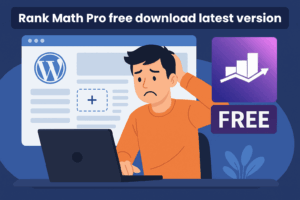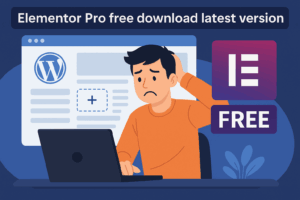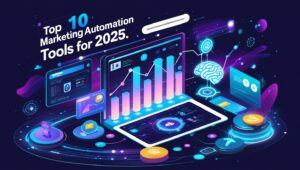In today’s competitive digital landscape, understanding how to rank on Google effectively is crucial for achieving SERP success. Many website owners believe that backlinks are the only way to enhance their visibility online; however, this guide will show you that you can rank on Google even with zero backlinks. Through actionable SEO strategies, you will discover various techniques to boost your organic search traffic without relying on external links. As the SEO landscape continues to evolve, the opportunity for growth without backlinks remains strong. By focusing on content quality, user experience, and targeted keywords, you can improve your search engine rankings and drive more visitors to your site. Get ready to unlock the potential of organic visibility.
Table of Contents
ToggleKey Takeaways
- It is possible to rank on Google without backlinks.
- Quality content and user experience are essential for search rankings.
- Targeting long-tail keywords can enhance your SEO efforts.
- Optimize your website structure for better visibility.
- Leverage local SEO for increased online presence.
- Consistently analyze and adjust your SEO strategies for optimal results.
Understanding Google’s Ranking Algorithms
Google ranking algorithms play a crucial role in determining how content appears in search results. These algorithms evaluate various factors, demanding a focus on content quality and user experience to achieve optimal rankings. Websites that prioritize these elements are likely to see superior visibility in search engine results pages (SERPs).
The Importance of Content Quality
High content quality is fundamental to effective SEO. Google favors content that is relevant, informative, and engaging. When users find value in a website’s content, they tend to stay longer and interact more, leading to positive signals that the algorithms recognize. This relationship between content quality and user engagement drives organic traffic, offering a compelling reason for creators to invest in their content development processes.
User Experience as a Ranking Factor
User experience encompasses various SEO factors that significantly impact rankings. Aspects such as page speed, mobile-friendliness, and navigation must be optimized to enhance user satisfaction. A seamless experience encourages visitors to explore more pages, further signaling to Google that the site is valuable. Prioritizing both content quality and user experience creates a robust approach to complying with Google’s evolving ranking algorithms.
How to Rank on Google with Zero Backlinks
To achieve robust organic rankings without relying on zero backlinks, it is crucial to implement effective on-page SEO strategies. These strategies optimize various elements on your website, such as meta tags, headings, and images, providing search engines with valuable information about your content. Understanding how to enhance these components can significantly improve visibility in search results.
The Role of On-Page SEO
On-page SEO encompasses numerous practices aimed at optimizing individual pages to rank higher. Key elements include writing quality meta descriptions, optimizing title tags, and ensuring proper header hierarchy. Attention to detail in these areas can increase the chances of surging in search results. Engaging content that meets user intent is essential in keeping visitors on your site longer, which in turn can positively influence your rankings.
Targeting Long-Tail Keywords
Long-tail keywords play a fundamental role in any effective SEO strategy. These specific phrases generally have lower competition and higher conversion rates compared to broader keywords. By using tools like Ahrefs or SEMrush, you can discover these phrases that searchers are actively using. Crafting content around long-tail keywords not only enhances relevance but also helps capture targeted traffic, leading to improved organic rankings.
Creating High-Quality Content That Engages
Effective content creation necessitates an understanding of your audience’s needs. By developing quality content that meets these needs, you can significantly enhance audience engagement. Engaging with your audience goes beyond mere information delivery; it involves creating an emotional connection through relevant and resonate topics. Researching your audience’s interests can guide content development, ensuring it resonates well with them.
Identifying Your Audience’s Needs
To produce impactful content, identify what your audience is searching for. Conduct surveys or analyze platforms like Google Trends to gather insights. Understanding pain points and preferences allows for the creation of tailored content. Delving into social media discussions will also shed light on trending topics, helping you address specific questions and concerns.
Using Visuals to Enhance Content
Incorporating visuals can significantly boost audience engagement. Images, infographics, and videos not only break down complex information but also make the content more appealing. Quality visuals complement written content, making it easier for readers to digest and retain key points. Tools like Canva or Adobe Spark can assist in creating engaging graphics that align with your quality content strategy.
| Type of Visual | Benefits |
|---|---|
| Images | Enhance visual appeal and provide context. |
| Infographics | Simplify complex data into digestible formats. |
| Videos | Increase engagement through dynamic storytelling. |
Optimizing Your Website's Structure
Creating an effective website structure plays a crucial role in enhancing visibility and user experience. A well-optimized site not only attracts visitors but also aids in effective SEO optimization. This section delves into the importance of mobile responsiveness and page loading speed, two pivotal elements that directly impact how users interact with a website.
Importance of Mobile Responsiveness
With the increasing use of smartphones for internet browsing, mobile responsiveness has become essential. A responsive design ensures that your website adjusts seamlessly to various devices and screen sizes, providing an optimal viewing experience. Google prioritizes mobile-friendly sites in its rankings, reflecting the shift towards mobile-first indexing. Implementing mobile responsiveness enhances user engagement, leading to lower bounce rates and higher conversion rates.
Enhancing Page Loading Speed
Page loading speed significantly affects user retention and search engine rankings. A site that loads quickly keeps visitors engaged, whereas slow loading times can result in users abandoning the page. Prioritizing efficient website structure can lead to improved loading times. Tools like Google PageSpeed Insights can help evaluate and optimize site speed. Reducing image sizes, leveraging browser caching, and minimizing JavaScript can contribute to faster loading speeds and a better overall user experience.

| Optimization Aspect | Impact on SEO | User Experience Benefits |
|---|---|---|
| Mobile Responsiveness | Increases search engine rankings | Improves accessibility on various devices |
| Page Loading Speed | Directly correlates with higher search rankings | Enhances user retention and satisfaction |
Utilizing Internal Linking Strategy
Internal linking plays a crucial role in enhancing your site’s SEO strategy and improving site navigation. By creating a strong internal link network, websites can distribute authority across various pages, helping search engines better understand the content and structure. Properly structured internal links not only boost SEO but also guide users through related content, increasing site engagement and reducing bounce rates.
Building a Strong Internal Link Network
To establish an effective internal linking strategy, consider the following best practices:
- Use descriptive anchor text that clearly indicates the destination page’s content.
- Link to older content that remains relevant, ensuring all resources are utilized to their maximum potential.
- Create a logical hierarchy, linking high-authority pages to lower-authority ones to distribute page rank effectively.
- Implement breadcrumbs to enrich user experience and improve site navigation.
Improving Navigation for Users
Improving site navigation enhances the overall experience for visitors. A well-structured internal linking system can:
- Help users find related topics quickly, keeping them engaged longer.
- Encourage deeper exploration of the site’s content, ultimately increasing page views.
- Reduce the time taken to find information, making browsing more efficient.
The integration of internal linking into the site architecture not only benefits SEO strategy but also prioritizes user satisfaction. A seamless navigation experience can lead to higher retention and conversion rates.
Leveraging Local SEO for Better Visibility
Local SEO plays a crucial role in enhancing business visibility within a specific geographic area. Companies aiming for increased local traffic should focus on establishing a strong online presence. Key tools such as Google My Business and local directories assist in improving search engine rankings and attracting potential customers. Understanding the setup and management of these tools can significantly impact local visibility.
Setting Up Google My Business
Claiming and optimizing your Google My Business profile is essential for effective local SEO. This platform allows businesses to manage their online presence across Google, including search results and Google Maps. To set up your profile, follow these steps:
- Visit the Google My Business website and click on “Manage Now.”
- Enter your business name and address accurately.
- Select the appropriate category for your business to help Google understand your services.
- Verify your business through the verification process outlined by Google.
- Make sure to provide complete and accurate information, including operating hours and contact details.
After verifying your business, updating your profile with images, posts, and responding to customer reviews can enhance visibility and engagement.
Getting Listed in Local Directories
In addition to Google My Business, securing listings in relevant local directories boosts local SEO efforts. These directories often include platforms such as Yelp, Angie’s List, and Yellow Pages. Here are some benefits of getting listed:
- Improves local visibility in search engine results.
- Increases credibility through verification by reputable sources.
- Provides potential customers with easy access to your services.
Ensure that your business details remain consistent across all directories. This consistency helps Google connect your information, boosting local search rankings.
Engaging with Your Audience Through Social Media
Social media serves as a vital tool for building connections with your audience and enhancing visibility. By fostering social media engagement, brands can create meaningful audience interaction and drive traffic to their platforms. Recognizing the right social media platforms is crucial for reaching target demographics and tailoring content effectively.
Choosing the Right Platforms
Identifying the most suitable social media platforms involves understanding where your audience spends their time. Popular options include:
- Facebook: Ideal for a wide range of demographics and versatile content types.
- Instagram: Perfect for visually-driven content and younger audiences.
- LinkedIn: A great place for professionals and B2B engagement.
- Twitter: Effective for real-time updates and interaction.
Select platforms based on your target audience’s preferences, ensuring that the content aligns with the unique characteristics of each platform.
Creating Shareable Content
To encourage audience interaction, focus on producing shareable content that resonates with users. Engaging visuals, compelling storytelling, and practical information can enhance the shareability of your posts. Consider the following strategies:
- Create lists: Lists are easy to digest and attract attention.
- Utilize infographics: Visually appealing graphics can convey complex information simply.
- Incorporate emotional triggers: Content that evokes emotions is more likely to be shared.
- Encourage participation: Pose questions or challenges to spark audience interaction.
By strategically crafting content that encourages sharing, you enhance your potential for greater social media engagement and significantly increase brand visibility.
Analyzing Your Performance and Making Adjustments
Effective performance analysis is crucial in optimizing your SEO strategy. Utilizing Google Analytics offers invaluable insights into user behavior, highlighting how visitors interact with your website. By tracking site traffic and engagement metrics, you can uncover patterns that inform necessary adjustments to improve overall performance.
The Importance of Google Analytics
Google Analytics serves as a powerful tool for monitoring how users engage with your site. It provides data on traffic sources, enabling you to assess which channels drive the most visitors. Understanding this data contributes to effective performance analysis, allowing for targeted strategies that capitalize on your most successful traffic sources.
Regularly monitoring site traffic and engagement metrics supports informed decision-making. By analyzing user actions, you can identify content that resonates with your audience. This analysis assists in refining your content strategy, ensuring that you focus on topics and formats that yield the highest engagement and retention rates.

Employing Google Analytics effectively requires identifying key performance indicators (KPIs) relevant to your goals. By monitoring metrics such as bounce rate, average session duration, and pages per session, you can gain a comprehensive view of user experience and content performance. These insights will guide your ongoing adjustments, enhancing both user satisfaction and site visibility.
| Metric | Definition | Importance |
|---|---|---|
| Bounce Rate | Percentage of visitors who leave after viewing only one page | Indicates how well your content captures attention |
| Average Session Duration | Average time users spend on your site | Reflects user engagement and content value |
| Pages per Session | Average number of pages viewed by a visitor | Shows depth of user engagement and navigation |
In summary, leveraging tools like Google Analytics for robust performance analysis enables you to make data-driven adjustments. Continuous monitoring of site traffic and engagement metrics will empower you to refine your SEO strategy effectively.
Staying Updated with SEO Best Practices
The world of SEO is constantly evolving, making it essential for professionals to stay informed about the latest trends and algorithm changes. Continuous education is crucial for maintaining a competitive edge in this fast-paced field. Engaging with industry updates through various platforms can significantly contribute to your understanding of SEO best practices.
Following Industry Blogs and Forums
Regularly visiting recognized industry blogs and participating in SEO forums can enhance your knowledge. Reputable sources often provide insights into algorithm updates and share effective strategies. Consider exploring the following platforms:
| Platform | Type | Description |
|---|---|---|
| Moz | Blog | Offers comprehensive guides and articles on SEO strategies and best practices. |
| Search Engine Journal | Blog | Covers a wide range of SEO topics, industry news, and expert opinions. |
| SEO Chat | Forum | A community-driven platform for discussions, tips, and sharing experiences in SEO. |
| Warrior Forum | Forum | Includes discussions on SEO and digital marketing strategies, helpful for beginners and experts. |
Participating in Online Courses and Webinars
Engaging in online courses and webinars can provide structured learning opportunities. Many platforms offer courses tailored to different skill levels, helping individuals enhance their SEO capabilities. Consider enrolling in options such as:
- Google Analytics Academy: Offers free courses on analytics to monitor performance.
- SEMrush Academy: Provides courses on SEO, content marketing, and paid strategies.
- HubSpot Academy: Covers inbound marketing techniques, including SEO practices.
Conclusion
In the quest for ranking on Google without relying on backlinks, the strategies outlined throughout this guide highlight the feasibility of achieving significant results. By focusing on effective SEO strategies such as optimizing content quality, enhancing user experience, and implementing robust on-page techniques, even newcomers can navigate the complexities of search engine optimization successfully.
The insights shared emphasize the critical importance of crafting engaging content that resonates with your target audience while also considering technical factors such as mobile responsiveness and site structure. These elements collectively contribute to generating organic traffic, which is essential for visibility in today’s competitive online landscape.
Persistence and adaptability are paramount in the ever-evolving world of SEO. To truly capitalize on the discussed strategies, readers should embrace a mindset of continuous learning and experimentation. By progressively implementing these techniques, you can confidently work toward achieving your goals of ranking on Google, even with zero backlinks.
FAQ
How can I rank on Google without any backlinks?
You can achieve a solid ranking on Google through effective on-page SEO tactics, optimizing for long-tail keywords, and focusing on high-quality content. Engaging your audience through user experience and utilizing internal linking can also significantly enhance your visibility.
What is on-page SEO and why is it important?
On-page SEO refers to the practice of optimizing individual web pages to rank higher and earn more relevant traffic in search engines. This includes optimizing meta tags, headings, images, and ensuring that your content meets the needs of your audience and adheres to Google’s algorithm guidelines.
How do I identify the needs of my audience?
Identifying your audience’s needs can be done through market research, surveys, and analyzing user engagement data. Tools like Google Analytics can help you understand audience behavior, while social media platforms can provide insights into their preferences and pain points.
Why is mobile responsiveness critical for SEO?
Mobile responsiveness is vital because Google uses mobile-first indexing, meaning it prioritizes the mobile version of websites for ranking. A responsive design enhances user experience, keeping visitors engaged on various devices and potentially lowering bounce rates.
What role does social media play in SEO?
Social media plays a significant role in SEO by driving traffic, increasing brand awareness, and fostering audience engagement. Creating shareable content can enhance your reach and indirectly influence your search engine rankings by generating additional traffic and interactions.
How can I improve my website’s loading speed?
Improving your website’s loading speed can be achieved by optimizing images, reducing server response time, leveraging browser caching, and utilizing content delivery networks (CDNs). Tools like Google PageSpeed Insights can help you identify specific areas that need improvement.
What is the significance of Google My Business for local SEO?
Google My Business is essential for local SEO as it allows businesses to manage their online presence on Google, including search and maps. Optimizing your profile can boost visibility in local search results and make it easier for potential customers to find and contact your business.
How do I analyze my site’s performance and make necessary adjustments?
You can analyze your site’s performance by utilizing tools like Google Analytics to monitor traffic sources, user behavior, and engagement metrics. By regularly reviewing this data, you can identify successful strategies and areas that require adjustments to enhance your overall SEO efforts.
What resources should I follow to stay updated with SEO best practices?
To stay updated with SEO best practices, follow reputable industry blogs such as Moz, Search Engine Journal, and Neil Patel’s blog. Engaging in online forums and participating in webinars or courses can also keep you informed about the latest trends and algorithm updates in the SEO landscape.











